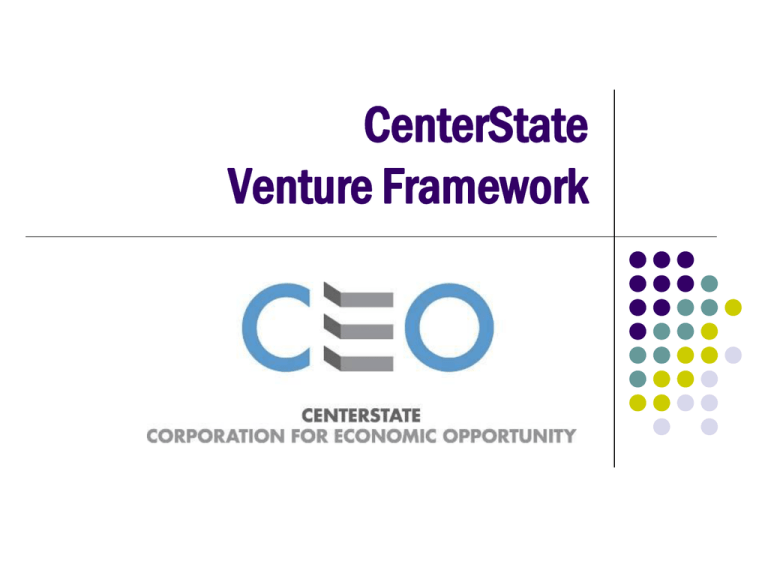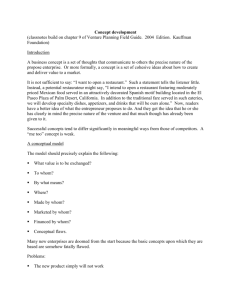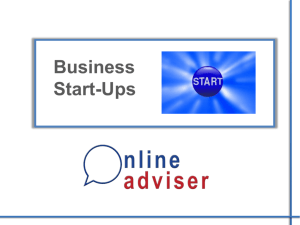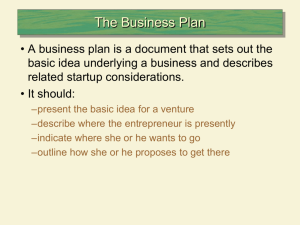CenterState Venture Framework
advertisement

CenterState Venture Framework Innovation happens here Ideation Startup Emerging Accelerating Connecting the dots for entrepreneurs An intellectual infrastructure and partnerships with universities, public and private research labs, and industry collaborators Strategic programs that provide a structure for transferring knowledge, coaching and mentoring, and shaping strategy Physical infrastructure that includes robust incubation and acceleration facilities where creative intellectual collisions, idea exchange, and entrepreneurial synergies propel growth Connections to find talent as a company hits rapid scale-up Sources of risk capital and other financing to help fast-track companies manage stages of growth. Startup Solutions: Innovation in a box Tech Garden Innovation Ecosystem Grants for Growth Emerging Business Plan Competition The Clean Tech Center SyracuseCoE Partnership/ CAP/TAD grants The Student Sandbox Launch > Connect > Accelerate Tech Garden Innovation Ecosystem B-Venture Startup Series Jump Start NY / EDA Regional Innovation Partnership Pre-Seed Workshops SBA e200 Partnership SmartStart/UNYTECH Venture Forum Partnership Technical Forums and Expos Tech Meetup Network UVANY Partnership The Tech Garden Process: Getting Startups “Investment Ready” A one-stop team approach with in-house experts, EIRs and experienced mentors to coach early stage and acceleration companies through business plan development, path to market, technology testing and validation, funding strategy, and sources of private/public capital that match each stage of development In-house resources NYBDC Anchor Tenant: 127member bank lender / CDC that is the third largest SBA lender in the country, with a $1 billion loan portfolio in NYS Full-time NYBDC Financial Entrepreneur in Residence on site to assist companies on structuring financing SBDC counseling on-site SCORE counseling on-site SBA workshops on-site The Venture Development Framework Step One: Ideation Scoping process: What is status of the technology? What is IP position? What proof of principle is required? What resources are needed? What is best path? (License vs. build and sell, vs. staged growth?) Is founder an entrepreneur who is capable of next steps? Step Two: Incubation Creation of venture assistance plan: Definition of technology and performance specifications Validation of those capabilities Understanding of market feasibility Comprehension of basic payback economics Business plan development Sales and marketing strategy Funding strategy to bridge “The Valley of Death” Step Three: Demonstration Technical proof and market potential: Prototype development Demonstration of performance at batch scale / alpha testing Understanding of manufacturing costs/standards Costs of goods analysis Supply chain/customer research Tangible proof of product performance at small commercial scale / beta testing Scale-up strategy Step Four: Deployment Market adoption: Early adopter program to speed path to market and accelerate market feedback Commercial validation Identification of strategic partners Development of sales channels First round hires and personnel plan Step Five: Acceleration Implementation of a comprehensive business plan: Financial model in place, along with funding strategy to bridge “The Mountain of Growth” Core management team in place/outside advisory board Payback economics demonstrated, with articulated ROI Investor pitch and collateral materials in place/refined business plan/ series of pitch rounds to funders Investment event or other resource transaction that validates the technology and the market opportunity Hiring up to match successful commercial sales And after that? Looking ahead: Exit event (strategic joint venture/sale/public offering) Or continued staged growth with next stage growth capital planning Where entrepreneurs need help Identifying the appropriate phase of commercialization Determining proof required at each phase Connecting with resource providers required at each phase Outlining appropriate milestones and measures of progress at each phase Developing a plan to produce the proof and pursue the path to commercialization Some honest questions What service or product does your business provide and what needs does it fill? Is it truly compelling? Who are your potential customers and why will they buy this service or product from you? How will you reach your potential customers? Where will you get the financial resources to start your business? How much risk are you willing to take? How hungry are you? Are you an entrepreneur? What skills are you good at? What are you lacking? Where can you find help in those areas? Is your business concept practical? What’s your advantage? Is there a real demand for what you do? Do you have the stamina and drive to run a business? Are you good at making decisions? Are you organized? Can you move quickly? Why business plans fail Good planning but poor organization … financials, inventory, records, schedules, production, sales Insufficient capital Poor location Poor inventory control Management team disputes Over investment in fixed assets Inability to manage risk Weak sales channel strategy / focus on marketing instead of sales Inability to manage cash flow through good and bad times The good news: There is help There are excellent regional resource providers Academic TTO’s Early stage business assistance organizations R&D Partners Rapid prototyping, contract manufacturing Strong regional supply chains Connections for talent Access to capital www.centerstateceo.com www.thetechgarden.com www.thecleantechcenter.com www.creativecoreny.com




![Chapter 3 – Idea Generation [ENK]](http://s3.studylib.net/store/data/007787902_2-04482caa07789f8c953d1e8806ef5b0b-300x300.png)


